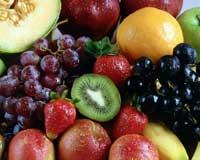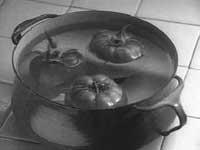Vitamins: sparks of life
Formerly some doctors discovered the direct relationship of certain incorrect eating habits with various diseases. Therefore, VII. In the nineteenth century it was possible to avoid beriberia and in the twelfth century the scurvy. To protect themselves from these diseases, doctors realized that it was enough to introduce certain foods into the daily diet. In fact, the unknown substances found in these foods, vitamins, fulfilled this protective function. These nutrients, therefore, made known the diseases that generated their deficiencies, but they still did not know why.

At the beginning of this century numerous researchers began experimenting with animals. They started giving special meals composed exclusively of carbohydrates, proteins, fats and minerals, and realized that animals did not grow, they realized the importance of vitamins. We need very small amounts, but they are essential for the good reaction of the body. Although each has its own functions, all of them regulate all the reactions that occur in our body to obtain energy and are divided into two groups:
- Melted in water: As vitamin C and all of group B (B1, B2, B6, B12, niacin, …) do not build up in the body, what is not used is removed by urine.
- Degreasing agents: Vitamins A, D, E and K are characterized by their accumulation in the body.
Vitamins that melt in water
Vitamin C
Also known as ascorbic acid, it has among its regular functions various metabolism reactions. It is also known to have a protective function against infection and flu. An adult needs 50-60 mg/day and in our diet, as necessary, if we introduce daily fruit and vegetables, it is easily obtained. However, you should know that some fruits contain more vitamin C than others, such as orange, lemon, grapefruit, kiwi and strawberry. Tomato and potato salad also have, but as we eat the last cooked or fried, it gets undone and lost by the heat.
The lack of this vitamin causes a scurvy that was formerly known as the disease of sailors, with dental bleeding, tooth fall, anemia, weakness, etc. But as already mentioned, just take orange and kiwi or fresh salad daily so that it does not happen.
Group B
There are many vitamins that this group contains and although above we will analyze them individually:
Vitamin B1 or thiamines
By participating in carbohydrate metalism what we need daily is 1-1.15 mg. Pork and germ are rich in vitamin B1. The lack produces beriberia, that is, changes in the cardio-nervous system, irritability, psychic disorders, etc.
Vitamin B2 or riboflavins
It regulates the metabolism of carbohydrates, fats and proteins and is directly related to the physical development of children. Requires 1,2-1.7 mg/day. Although in very small amounts it is found in meats, milk and green vegetables. The symptoms of deficiency are quickly reproached (cuts of the lips, dermatitis, wounds in the mouth, …) so its absence is easily detectable.
Vitamin B6 or pyridoxins
It has to do mainly with reactions with proteins. Therefore, it is related to the protein consumed daily, an average of 1,6-2 mg/day is required. The most abundant sources are legumes, potato, ……, banana, avocado, pumpkin, carrot, chicken and turkey. Lack causes nervous and skin problems, such as depression.
Folic acid
We have another vitamin from this group and, like vitamin B6, it participates in the use of proteins. Between 100 and 200 mg daily are needed. One of its main characteristics is the doubling of your needs during pregnancy, which can reach 400 mg. Abundant in all green leafy vegetables (azelgak, spinach, borage, …). If needs are not met, megaloblastic anemia occurs, digestive tract problems and delayed physical development in children.
Vitamin B12 or cyanocobalamines
It influences the growth of intestinal and nerve cells. Requires 2 mg/day. It is only found in animal products. Its lack causes damage to the nervous system.
Niacin, biotin, and pantothenic acid belong in the same group. But since they are widespread in nature, their shortcomings are not palpable. Therefore, we will not mention them.
Vitamins that melt in fats
Vitamin A

Also known as Retinol. Some precursor substances of this vitamin are carotenes. Therefore and as it is melted in fats, although it is found in foods containing fat such as retinol (milk, liver, egg yolk, butter, etc. ). ), as carotene is found in yellow-orange vegetables; carrots, pumpkin, etc.
Its main function is to keep your eyes and skin in good condition. Consequently, deficiencies of vitamin A -night blindness, drying of the skin, etc. brings. To see well the essence of the old saying of dihos it is necessary to eat a lot of carrots.
Lately there has been much talk about its role as an antioxidant, its importance in cancer prevention. We need 800-1000 mg/day to avoid shortages. This amount is easily obtained from a varied diet.
Vitamin D
One of the main sources of this vitamin that helps growth and participates in the development of bones and teeth is the sun. In fact, the ultraviolet ray that contains activates one of the substances we have in the skin, turning it into vitamin D. Therefore, in hot countries it is difficult to find the lack of this vitamin.
It is also found in milk and dairy products, egg, butter, cereals and liver. It is recommended to take 5 mg/day and, as mentioned, in summer it is needed less due to the sun.
The lack causes a known rickets for a long time. Because of this disease, the bones do not develop properly, so they bend and deform. People affected by this disease should sunbathe and the above mentioned foods as far as possible.
Vitamin E
This vitamin also known as Tokoferol, for its antioxidant function, acts against aging. It inhibits oxides that cause aging of tissues. They are needed between 8 and 10 mg/day and can be found mainly in seed oils, that is, in sunflower oil and corn.
Vitamin K

Its main characteristic is that 50% of the needs of this vitamin come from beneficial intestinal bacteria. Consequently, lack is usually exceptional. The other half of the needs (30-40 mg/day) will be achieved by dieting eggs, cheeses, liver and green vegetables (spinach, chard, …).
If for some reason we do not reach that level, we will have problems in coagulation, since the function of this vitamin is to produce clotting substances. Therefore, the symptoms are unjustified bleeding and wounds with difficulty healing. To correct it, first you have to know the causes (some intestinal problem, inadequate eating habits, …) and then, establish a solution based on it.
Once we have seen the above, we only have to confirm that vitamins are essential. But you also need to know that many foods offer a lot of energy than not vitamins. Therefore, let's try to differentiate the foods we take from those rich in vitamins.
Tips for keeping vitaminsOnce the food in which vitamins are found has been checked, here are some simple tips so that their losses, especially those that melt in the water, are the minimum possible. First of all, it must be borne in mind that the food offered by each season will be the richest in ingredients, especially with regard to vitamins, for example, the tomatoes found in February have nothing to do with those of August. Therefore, the ideal is to feed on the vegetables of each season. But look! There are criteria to consider when buying. Buy the freshest vegetables possible. In the case of green vegetables, they should be free of rot and leaf marching. The easiest way to know is to look at the vegetable in the part that has been cut, if it is white it is cool, if it is blackened or blackened it takes days at the point of sale. Since there are currently different technologies for the treatment of food, those that do not have time and availability for the purchase and preparation of fresh food, you should not worry, there are products preserved in different ways and on the market. But don't think they are all the same, because depending on the process they suffer, the number of components varies a lot. For example, packaged vegetables, due to heat effect, lose some vitamins and when they reheat at home lose others, leaving very little vitamins. However, there is another form of conservation and if the initial product is of good quality and used correctly, the product can be both fresh and good: freezing. If several fresh vegetables are frozen in suitable conditions, that is, at very low temperature and in a very short time, and while the vegetable comes home does not break the chain of freezing, it retains quite well its properties and the loss of vitamin suffering is less than that of preserves. Finally, in order to make the losses in the kitchen minimal, it must be taken into account that you do not have to cut the very small vegetables and that in the pot there is only enough water to cover the vegetables. The water should be boiling and not lose the boil, to do this you should put small fists. Then, between 5 and 15 minutes are enough to cook, depending on the vegetable. In order to maintain the green color, add bicarbonate, but it is not appropriate, since the basic medium that generates this substance prevents it. Instead, lemon or vinegar are good, because in acid medium the vitamins stay better. On the other hand, there are certain vitamins that in cooking pass to the water and that the ideal is to take advantage of this water by making broth and creams instead of throwing it from the sink. Enjoy and live healthy! |





